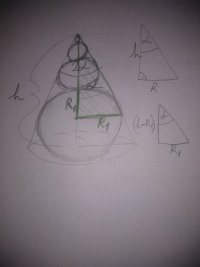Here's the text of the problem:
In a right cone of radius of the base R and the angle at the top of its axial section 2A, a sphere is inscribed. Then, a sphere which touches the first one as well as the wrapper of the cone is also inscribed etc. in infinity. Calculate the sum of the areas of this infinite progression of spheres.
I understood it as if spheres are being piled on top of one another, heading towards the tip of the cone, in infinity. So, this is how I tried to solve it ( and failed apparently ).
[imath]ctgA = h/R\\ h = R * ctgA\\ ctgA = (h - R_1)/R_1 = (R*ctgA - R_1)/R_1\\ R_1 = R*ctgA/(ctgA + 1)\\ ctgA = (h - (2R_1 + R_2))/R_2\\ R_2 = (R*(ctgA)^2 - R*ctgA)/(ctg + 1)^2 = R*ctgA(ctgA - 1)/(ctgA + 1)^2\\ R_2 / R_1 = (ctgA - 1)/(ctgA + 1)\\ R_2^2 / R_1^2 = (ctgA - 1)^2/(ctgA + 1)^2 = q\\ S = 4\pi*R^2*(ctgA )^2/(ctgA + 1)^2*(1 + (ctgA - 1)^2/(ctgA + 1)^2 +...)\\ S = 4\pi*R^2*(ctgA )^2/(ctgA + 1)^2*(1 / (1 - q))\\ S = 4\pi*R^2*(ctgA )^2/(ctgA + 1)^2 * (1/4ctgA)\\ S = \pi*R^2*ctgA*(1/(ctgA + 1)^2)\\[/imath]
However, the final solution is supposed to be:
[math]\pi * R^2 * cosA * ctgA[/math]
This basically means that, if I calculated all the steps properly, my 1/(ctgA + 1)^2 is supposed to equal cosA, which it doesn't.
The ''official solution'' ( presented in the workbook ) it says that the progression goes as follows:
[math]R*cosA/(1 + sinA), R*cosA/(1 + sinA), ((1 - sinA)/(1 + sinA))^2,...[/math]
And it also says: "In solving this problem we use the equation:
[math]tg(\pi/4 - A/2) = cosA/(1 + sinA)[/math]"
Could someone help me out on this one ?
Thank you immensely !
In a right cone of radius of the base R and the angle at the top of its axial section 2A, a sphere is inscribed. Then, a sphere which touches the first one as well as the wrapper of the cone is also inscribed etc. in infinity. Calculate the sum of the areas of this infinite progression of spheres.
I understood it as if spheres are being piled on top of one another, heading towards the tip of the cone, in infinity. So, this is how I tried to solve it ( and failed apparently ).
[imath]ctgA = h/R\\ h = R * ctgA\\ ctgA = (h - R_1)/R_1 = (R*ctgA - R_1)/R_1\\ R_1 = R*ctgA/(ctgA + 1)\\ ctgA = (h - (2R_1 + R_2))/R_2\\ R_2 = (R*(ctgA)^2 - R*ctgA)/(ctg + 1)^2 = R*ctgA(ctgA - 1)/(ctgA + 1)^2\\ R_2 / R_1 = (ctgA - 1)/(ctgA + 1)\\ R_2^2 / R_1^2 = (ctgA - 1)^2/(ctgA + 1)^2 = q\\ S = 4\pi*R^2*(ctgA )^2/(ctgA + 1)^2*(1 + (ctgA - 1)^2/(ctgA + 1)^2 +...)\\ S = 4\pi*R^2*(ctgA )^2/(ctgA + 1)^2*(1 / (1 - q))\\ S = 4\pi*R^2*(ctgA )^2/(ctgA + 1)^2 * (1/4ctgA)\\ S = \pi*R^2*ctgA*(1/(ctgA + 1)^2)\\[/imath]
However, the final solution is supposed to be:
[math]\pi * R^2 * cosA * ctgA[/math]
This basically means that, if I calculated all the steps properly, my 1/(ctgA + 1)^2 is supposed to equal cosA, which it doesn't.
The ''official solution'' ( presented in the workbook ) it says that the progression goes as follows:
[math]R*cosA/(1 + sinA), R*cosA/(1 + sinA), ((1 - sinA)/(1 + sinA))^2,...[/math]
And it also says: "In solving this problem we use the equation:
[math]tg(\pi/4 - A/2) = cosA/(1 + sinA)[/math]"
Could someone help me out on this one ?
Thank you immensely !

